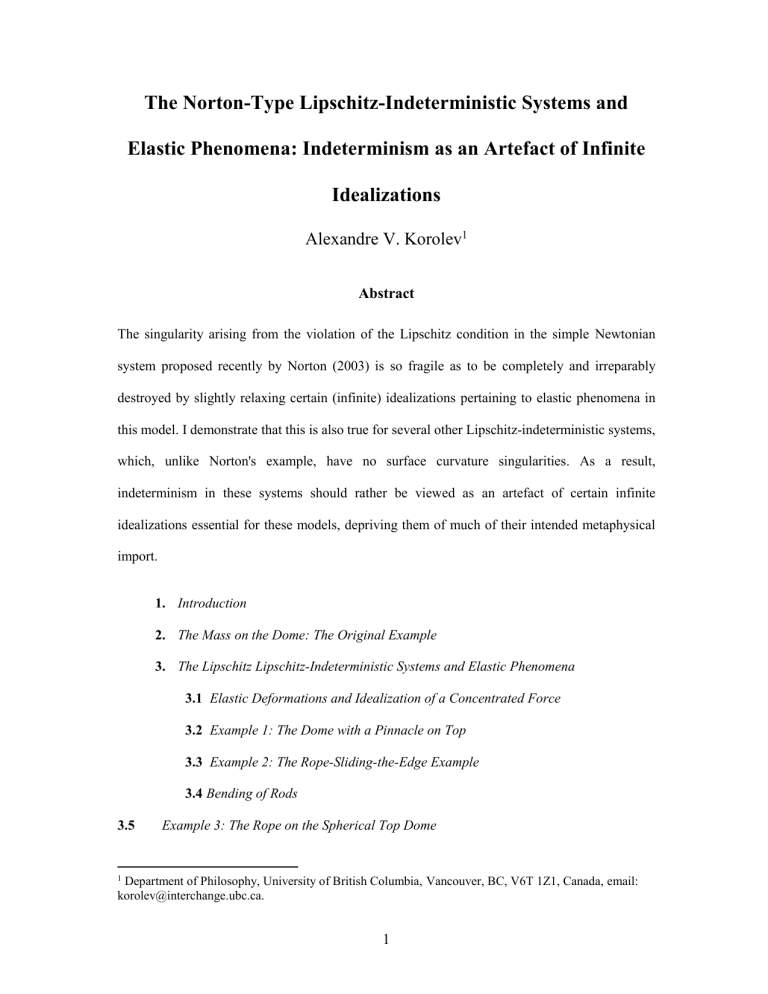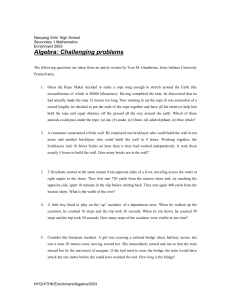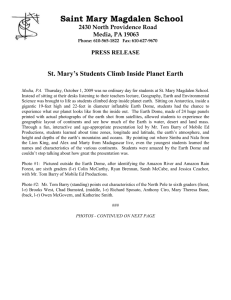Introduction - PhilSci
advertisement

The Norton-Type Lipschitz-Indeterministic Systems and
Elastic Phenomena: Indeterminism as an Artefact of Infinite
Idealizations
Alexandre V. Korolev1
Abstract
The singularity arising from the violation of the Lipschitz condition in the simple Newtonian
system proposed recently by Norton (2003) is so fragile as to be completely and irreparably
destroyed by slightly relaxing certain (infinite) idealizations pertaining to elastic phenomena in
this model. I demonstrate that this is also true for several other Lipschitz-indeterministic systems,
which, unlike Norton's example, have no surface curvature singularities. As a result,
indeterminism in these systems should rather be viewed as an artefact of certain infinite
idealizations essential for these models, depriving them of much of their intended metaphysical
import.
1. Introduction
2. The Mass on the Dome: The Original Example
3. The Lipschitz Lipschitz-Indeterministic Systems and Elastic Phenomena
3.1 Elastic Deformations and Idealization of a Concentrated Force
3.2 Example 1: The Dome with a Pinnacle on Top
3.3 Example 2: The Rope-Sliding-the-Edge Example
3.4 Bending of Rods
3.5
Example 3: The Rope on the Spherical Top Dome
1
Department of Philosophy, University of British Columbia, Vancouver, BC, V6T 1Z1, Canada, email:
korolev@interchange.ubc.ca.
1
1. Introduction
Scientific theories employing mathematical models "approximate" or "idealize" in one
way or another. Whereas much attention in philosophy of science has been drawn to the
role of idealizations in the development of scientific theories (e.g., McMullin 1985,
Cushing 1990, Moulines 1996, see also Redhead 1980, Laymon 1985, 1995, and
Hartmann 2005a, 2005b), it is admissibility of idealizations in theorizing that will be of
main interest in this section. I will argue that certain idealizations required by recently
proposed Norton's simple Newtonian Lipschitz-indeterministic system are so extreme as
to be considered physically inadmissible. Norton himself uses this example to support
his vision of causality as a notion belonging more in folk science rather than being a
fundamental principle underlying all natural processes and unifying all the domains of
science at some deeper level. In this paper I intend to demonstrate that his mass on the
dome example fails to provide support for such a view. I argue that the singularity
arising from the violation of the Lipschitz condition in this example is so fragile as to be
completely and irreparably destroyed by slightly relaxing certain (infinite) idealizations
required by this model. In particular, I show that the idealization of an absolutely
nondeformable, or infinitely rigid, dome is an essential assumption for anomalous
motion to begin; any slightest finite elastic deformation of the dome due to finite rigidity
of the dome irreparably destroys the shape of the dome required for indeterminism to
obtain. I further demonstrate that this situation cannot be remedied by making the dome
a little "pointier" at the apex, in the hope that the dome assumes just the right shape after
it is "squished" down by the weight of the mass placed on top of the dome.
2
I also exhibit and examine several further situations – the rope-on-the-edge
example and the rope-on-the-spherical-dome example – which, unlike the original
Norton's example, have no surface curvature singularities, and show that indeterminism
in these cases, too, critically depends on the nature of certain infinite idealizations
pertaining to elastic properties of the bodies in these models. Most specifically, the
idealization of an infinitely flexible rope appears to be an essential assumption for
indeterminism to obtain; the rope of any finite degree of stiffness appears to be unable to
follow the specific time-reversible shape of the underlying surface, thus blocking the
time reversibility argument.
As a result, I argue that indeterminism of these Norton-type Lipschitzindeterministic systems should rather be viewed as an artefact of certain infinite
idealizations essential for the models, depriving the examples of much of their intended
metaphysical import, as, for example, in Norton's antifundamentalist programme.
The paper is organized as follows. Section 2 introduces Norton's original mass-onthe-dome example and the time reversal argument. Section 3 is concerned with elastic
phenomena that take place in the Norton-type indeterministic systems and the
idealization of a concentrated force that appears critical in the discussion of timereversibility of the system’s evolution. Here I also exhibit and examine several other
Lipschitz-indeterministic systems and show that certain idealizations required by these
examples are, too, so extreme as to be considered physically inadmissible.
2. The Mass on the Dome: The Original Example
A unit point mass slides frictionlessly on the surface under the action of gravity. The
surface is shaped as a symmetric dome described by the equation:
3
y(r) 2 r3 2 ,
3g
(1)
where r is the radial coordinate in the surface, i.e., the distance traveled by the mass from
the highest point of the dome along the surface, | y | specifies how far the dome surface
lies below the apex as a function of r, and g is the acceleration due to gravity (Fig. 1):
Fig. 1 Mass sliding on the dome.
At any point, the magnitude of the gravitational force tangential to the surface is
F
d ( gy )
r1 2 and is directed outward. Newton's second law of motion, F ma ,
dr
applied to the mass on the surface gives
d 2r
r1 2 .
dt 2
(2)
If the mass is initially located at rest at the apex r 0 , then one obvious solution
to (2) for all times t is a trivial one:
r (t ) 0 .
(3)
4
The mass simply remains at rest for all times. However, there exists another large
class of unexpected solutions. For any radial direction,
4
1 (t T ) , for all t T
r (t ) 144
,
0, for all t T
(4)
where T 0 is an arbitrarily chosen constant. By direct computation one can readily
confirm that (4) satisfies Newton's second law (2).
Note that equation (4) describes a point mass sitting at rest at the apex of the
dome, whereupon at an arbitrary time T 0 it spontaneously moves off in some
arbitrarily chosen radial direction.
The solutions (4) appear to be fully in accord with Newton's second and first laws,
if one takes the first law in its instantaneous form as follows:
In the absence of a net external force, a body is unaccelerated.
Indeed, for all times t T , there is no net force applied, since the body is at
position r 0 , the force free apex; and the mass is unaccelerated.
For all times t T , there is a non-zero net force applied, since the mass is at
positions r 0 not the apex, the only force free point on the dome; and the mass
accelerates in accord with F ma .
Finally, when t T , the direct computation of the mass acceleration from the
equation (4) gives us
1 (t T ) 2 , for all t T
12
a (t )
,
0, for all t T
(5)
so that at t T , the mass is still at the force-free apex r 0 and the mass acceleration
a (0) is equal to zero. Again, no force, no acceleration, exactly as the first law requires.
5
What about the initiating cause that sets the mass in motion in the first place?
Surely the instant t T is not the first instant at which the mass moves; it is the last
instant at which the mass does not move. In fact, one can name no first instant at which
the mass moves. So, if there is no first instant of motion, then there is no first instant at
which to seek the initiating cause.
Yet another powerful argument can be given in support of acausality of the mass
motion. This argument involves the time reversal trick. Since the Newtonian dynamical
laws of gravitational systems are invariant under time reversal we can invert the slidingdown-the-dome scenario to produce another legitimate solution which insults the
principle of causality. Instead of having the mass starting at the apex of the dome, we
will imagine it starting at the rim and that we give it some initial velocity directed
exactly at the apex. If we give it too much initial velocity, it will pass right over the apex
to the other side of the dome. If we give it too small initial velocity, it will rise toward
the apex, but before it reaches the apex it halts and slides back to the rim. Now, if we
give the mass just the right amount of initial velocity, it will rise up and momentarily
halt exactly at the apex.
The proper mathematical analysis of the latter situation reveals that the time
required for the mass to reach the apex moving along the surface of this particular shape
is finite. That this time is finite is essential for the time reversal trick to succeed. Infinite
time would mean that the mass never actually arrives at the apex, and the time reversal
scenario would display a mass that has been in motion at all past times, without any
spontaneous launches. It should be emphasized that by no means this feature is common
to all domes. For hemispherical or parabolic domes, for instance, the time taken for the
6
mass to reach the apex to its momentary halt is unbounded. In the case of the dome of
Fig. 1 the time reversal trick does work.
3. Lipschitz-Indeterministic Systems and Elastic Phenomena
3.1 Elastic Deformations and Idealization of a Concentrated Force
In a real physical body that is not deformed, the arrangement of the molecules
corresponds to a state of thermal equilibrium; all parts of the body are in mechanical
equilibrium. This means that, if some portion of the body is considered, the resultant of
the forces on that portion is zero. When a change in the relative positions of molecules –
a deformation – occurs, the body ceases to be in its original state of equilibrium. As a
result, there arise forces which tend to return the body to equilibrium. These internal
forces which occur when a body is deformed are called internal stresses. If no
deformation occurs, there are no internal stresses.
The internal stresses in a real physical body are due to molecular forces, i.e., the
forces of (electro-magnetic) interaction between the molecules. The molecular forces
tend to have a very short range of action: their effect extends only to the neighbourhood
of the molecule exerting them, over a distance of the same order as that between the
molecules. On the other hand, the standard classical theory of elasticity, as a
macroscopic theory, considers only distances which are large compared to the distances
between the molecules. This being so, in many problems the atomistic structure of the
elastic medium can often be disregarded and the body replaced with by a continuous
mathematical model whose geometrical points are identified with material points of the
medium.
7
The internal forces determine the elastic properties of bodies, which
mathematically characterize certain functional relationships between forces and
deformations of elastic medium. As a result, the response of elastic body to the action of
forces (internal or external) is in no way arbitrary, but is subject to certain relationships
and constraints that may prove critical in many problems.
Consider the following problem from the classical theory of elasticity. Suppose we
are given a vertically symmetric dome of the (already familiar) form:
y ( x ) | x |3 2 .
The dome is made of infinitely divisible continuous elastic medium, and the
standard assumptions of the classical theory of elasticity are assumed to be in place. 2 We
want to determine the deformation of the dome under the action of a finite concentrated
force, applied vertically to just one point of the surface – the apex of the dome.
To solve this problem, we introduce polar coordinates, with an angle φ measured
from the direction of the applied force (Fig. 2):
2
See, e.g., Sokolnikoff (1956) and Thomas (1961). In particular, if a medium particle, initially at the point
xi , is displaced to the position x i at time t according to the relations xi i ( xi , t ) , these relations are
assumed to have a unique inverse at any time t, i must be continuous and differentiable functions of the
initial coordinates xi and the time t, and the functional determinants || xi / xi || and || xi / xi || are
different from zero everywhere.
8
Fig. 2 Deformation of the dome under the action of a concentrated force.
For any given radial distance from the apex r, the angle φ takes values from –φm to
φm, where
| tan m | | x y | | x |1 2 .
The components of the stress tensor, rr , , and r , can be expressed (in polar
coordinates r, φ) as derivatives of the stress function, (Landau and Lifshitz 1986, p.
21):
2
1
1 1 2
, 2 , r
.
rr
2
2
r r
r
r r r
Since at every point of the dome boundary except the apex where the force is
applied we have
r 0 ,
the stress function should satisfy the following conditions:
1
f1 ( ) ,
f 2 ( ) ,
r
r
9
for m ,m , and some functions f1 and f 2 not depending on r.
Substituting ( r, ) rf ( ) , the biharmonic equation of equilibrium for elastic
solid bodies (Landau and Lifshitz 1986, pp. 18, 48)
2
1 2
r 2 0
r r r
gives solutions for f ( ) of the following forms:
sin , cos , sin , and cos .
The first two of these correspond to stresses equal to zero identically, and it is only
the third one that gives the correct value for the force applied at the apex. Indeed,
projecting the internal stresses on directions parallel and perpendicular to the force F,
and integrating over the part of a small circle lying inside the dome and centered at the
apex, in the limit of zero radius we obtain
rr
r cos d F ,
rr
r sin d 0 ,
as required to balance the external force applied at the apex. From here we can get the
following solution:
( r, ) F r sin ,
rr ( r, ) 2Fr cos ,
r 0 ,
where F is the force per unit thickness of the dome.
10
These formulas determine the required stress distribution in the dome. Note that
the stress distribution is purely radial: only a radial compression force acts on any area
perpendicular to the radius. The lines of equal stress are the circles r d cos , which
pass through the apex and whose centres lie on the line of the action of the force F.
The components of the strain tensor are
urr rr E , u rr E , and ur 0 ,
where is Poisson's ratio and E is Young's modulus characterizing the elastic medium
of the dome.
Now, expressing the components of the strain tensor in terms of the derivatives of
the components of the displacement vector (in spherical polar coordinates):
urr
u
u
ur
1 ur
1 u ur
, 2ur
, u
,
r
r
r r
r
r
we can get the final expression for the displacement vector that solves our problem:
ur
u
2F
(1 ) F
log( r a ) cos
sin ,
E
E
2 F
2F
(1 ) F
sin
log( r a )sin
(sin cos ) .
E
E
E
Here the constants of integration have been chosen so as to give zero displacement
(translation and rotation) of the dome as a whole: an arbitrary point at a distance a from
the apex on the line of action of the force is assumed to remain fixed (Fig. 3):
11
Fig. 3 Logarithmic infinite well at the apex.
Looking at the formal solution just given we notice that it presents an infinitely
deep logarithmic well going all the way down from the apex. Assuming that the mass
always remains in contact with the surface on which it exerts the force (i.e., the mass
travels down with the surface as the latter is "squished" down by the mass), it follows
that there can be no trivial solution with the mass staying on (or sliding along) the
surface – the only shape of the dome that counterbalances a concentrated finite force
exerted by a point mass is the infinite logarithmic well.
That we get an infinitely deep well (as opposed to some finite "pimple" on the
surface) is not, perhaps, a totally surprising result: it is characteristic for this particular
model that the force is applied to just one point – the area of measure zero, thus
producing infinite pressure on the surface at the apex. Disallowing any fractures and
punctures of the surface which is taken to remain continuous at all times (yet infinitely
stretchable), the elastic surface will always give way under the infinitely sharp needle as
the latter pushes its way down. That is all to say that the problem of a point mass staying
12
on top of an elastic surface is not a well-posed problem in the first place – it cannot even
be set up properly within the classical theory of elasticity.
3.2 Example 1: The Dome with a Pinnacle on Top
The infinite logarithmic well also helps explain why the original Norton's mass-on-thedome formulation cannot be remedied by making the elastic dome surface a little
"pointier" at the apex, in the hope that the surface will assume just the right shape after
the mass is placed on top of the dome and "squishes" it down by its weight. Indeed,
consider, for example, the following modification of the dome with an arbitrarily high
and sharp conical pinnacle on top (with the non-zero angle 2 as close to zero, and the
height of the pinnacle, h, as high as desired) (Fig. 4):
Fig. 4 The dome with a pinnacle on top.
The stress distribution in such a pinnacle-shaped part of the dome due to a
concentrated force applied vertically to its apex is, obviously, given by the same
13
formulae as above with only difference being in their normalization constants. Namely,
the stress tensor components in this case are (Landau and Lifshitz 1986):
1
F
rr ( r, )
cos , r 0 .
1
sin 2 r
2
Such stress distribution, however, also gives rise to an infinitely deep logarithmic
well going all the way down from the top of the dome. Since this is true for any
arbitrarily high and sharp pinnacle, there is no way the new dome can assume the desired
shape at the apex after we place a point mass on its top.
3.3 Example 2: The Rope-Sliding-the-Edge Example
One may think that all the pathologies of the Norton's dome originate in the singularity
of the dome surface at the apex. Indeed, in the original Norton's setting it is the singular
non-smooth geometry of the surface in the immediate vicinity of the apex that is
essential for indeterminism to obtain; the rest of the surface plays no role in this
phenomenon and can be safely replaced by some other surface, or even merely removed.
Yet, as I will show in this and the following sections, the singularity of the surface at the
apex is in no way essential for indeterminism to occur and one can get anomalous
motion generation for everywhere smooth surfaces.
Recall that the primary resource responsible for non-uniqueness in Norton's case is
(spatial) Lipschitz-discontinuity of the direction field of the differential equation that
governs the system's dynamics. For a simple Newtonian gravitational system such as
Norton's dome it is equivalent to Lipschitz-discontinuity of the square root of the
potential wherein the mass moves. Correspondingly, we can expect similar
14
indeterminism in systems whose dynamics is governed by the same differential equation,
as long as the square root of their effective potential is non-Lipschitz.
Consider the following example.3 A flexible yet unstretchable rope of negligible
thickness lies motionlessly on a frictionless flat horizontal surface with one of its ends
touching the edge of the surface; beyond this point the surface descends abruptly with
the shape given by the equation expressed in usual Cartesian coordinates (Fig. 5):
y ( x ) | x |1 2 .
Fig. 5 The rope sliding down the edge.
When the rope slides down the edge by some distance x (in the x-direction), the
force exerted on any given point of the rope is
F ~ g h g | x |3 2 ,
where κ is the rope mass per length unit, and h measures the distance from the x-axis to
the sliding end of the rope. Equivalently, we may talk about the centre of mass of the
rope moving in the potential
3
This example was suggested by William Unruh (personal communication).
15
U ( x ) g | x |3 2 .
The rope moving in this effective potential, clearly, presents a similar dynamical
situation as that of Norton's point mass on the dome, giving rise to similar
indeterministic behaviour of the rope: for an arbitrarily long time the rope lies
motionlessly on the horizontal surface, when, suddenly, without any external
intervention or change in the environment, it starts sliding down the edge.
The fact that the rope-sliding-the-edge example has no point masses makes it of
special interest. No point masses, no concentrated forces, no infinite pressures on the
surface, and no infinite wells that would prevent the problem from being well posed in
the first place.
Also note that it is the rope's centre of mass the behaviour of which is governed by
the non-Lipschitz differential equation, and this centre of mass is now an abstract
mathematical point, not necessarily corresponding to any material point of the rope.
Indeed, once the rope slides off its original position, its centre of mass detaches from the
rope and moves to the depth of the medium that constitutes the slide. That the system's
centre of mass no longer necessarily tracks the path of the system itself is an important
feature that will allow us to further modify the example as to smoothen all singularities
in the surface while maintaining indeterministic non-Lipschitz dynamics.
Yet, before we do so, it is instructive to look more closely at the elastic
phenomena taking place in the immediate vicinity of the edge where the rope is bent
before it goes down the wall. More specifically, I will argue that the idealization of an
infinitely flexible rope in this situation is essential for indeterminism to occur; taking
into account any slightest elasticity effects (however small!) destroys any non-trivial
16
solution resulting in the rope's remaining motionless at all times with no spontaneous
motion generation.
3.4 Bending of Rods
Consider an elastic rope (or a rod) of finite, yet negligible, thickness. Assuming finite
stiffness of the rope, let us look carefully at its bending in the immediate vicinity of the
edge (Fig. 6):
Fig. 6 The bending of the rope in the immediate vicinity of the edge.
When a rope (or a rod) of non-zero thickness is bent, it is stretched at some points
and compressed at others. Lines of the convex side of the bent rod are extended, and
lines on the concave side are compressed. This being so, there is a neutral surface in the
rod that undergoes neither extension nor compression. This neutral surface separates the
region of compression from the region of extension.
Let us look at a bending deformation in a small portion of the length of the rod in
the immediate vicinity of the edge where not only the strain tensor but also the
17
magnitude of the displacements of points in the rod are assumed small. Taking a
coordinate system with the origin on the neutral surface in the portion considered, and
the x-axis parallel to the axis of the undeformed rod, we can suppose that the bending
occurs in the xy-plane. Not giving a general solution for all possible configurations of the
system, we give the expressions for the components of the displacement for a rod of
rectangular cross-section as it appears, e.g., in Landau and Lifshitz (1986):
ux xy R , uz yz R , and
uy
1 2
{x ( y 2 z 2 )} ,
2R
where R is the radius of curvature of the neutral surface at the edge.
Using these expressions, it can further be shown that the sides z 12 z0 of the
initially rectangular cross-section become z 12 z0 uz 12 z0 (1 y R) , i.e., no
longer parallel but still straight. The sides y 12 y0 , however, are bent into the
parabolic curves
y 12 y0 u y 12 y0
1 2
[ x0 ( 14 y02 z 2 )] .
2R
That the bottom edge of the rope of any finite degree of stiffness is bent into
parabolic curves makes it impossible for the rope to follow the underlying surface;
rope's refusal to follow the prescribed track once again blocks the time reversibility
argument – the rope stays on the horizontal surface forever.
There is another way to see that a finitely flexible rod cannot be deformed as to
make it stay in a close contact with the surface at every point when the surface
experiences a sudden change in directionality such as in the above example: the
18
displacements of the rod in the just given expressions diverge and cease to be well
defined if the radius of curvature of the neutral surface R reaches zero. This also helps
understand why an (initially straight and undeformed) rod with any finite degrees of
stiffness, when placed on top of Norton's original dome, detaches from the dome in a
manner closely resembling the detachment of the mass projectile when the latter passes
over the top with a non-zero velocity (Fig. 7):4
Fig. 7 The bending of the rope in the immediate vicinity of the apex.
Indeed, the radius of curvature R of Norton's original dome surface (or, more
precisely, that of any two-dimensional cross-section of the surface cut vertically through
the apex) is given by the following familiar expression of differential geometry:
R
(1 y2 )3 2
,
y
where the two-dimensional curve is given explicitly by the equation y f ( x ) | x |3 2
(Fig. 8):
4
Similar difficulties, it may be argued, may be expected when trying to force the mass to track the surface
by switching to a bead-on-the-wire example; deformations of the wire at the origin would, on a
microscopic level, presumably, diverge the bead unto a parabolic, not time-reversible, trajectory.
19
Fig. 8 The radius of the curvature of a plain curve.
This radius R (which, in the limit of infinitely thin rope lying on the dome,
coincides with the radius of curvature of the rope's neutral surface), clearly, tends to zero
when we approach the top of the dome.5
Yet, the next section will show that the situation can be improved still further as to
eliminate all singularities in the geometry of the surface while maintaining
indeterminism.
3.5 Example 3: The Rope on the Spherical Top Dome
Consider the following modification of the rope-sliding-the-edge example. A flexible (of
some finite degree of stiffness) yet unstretchable rope of negligible thickness lies
motionlessly on a frictionless symmetrical dome. In some vicinity of the top the dome is
spherical; beyond this spherical area the dome continues in a smooth manner as the
familiar power function (Fig. 9):
y ( x ) | x |3 2 .
5
The observation that the Gaussian curvature of Norton's dome at the apex is infinite first appears in
David Malament (manuscript). He seems, however, to think that this is merely a geometrical fact about the
surface which is no more physically troublesome that other idealizations employed in Newtonian theory.
20
Fig. 9 The rope sliding down the spherical top dome.
The rope initially lies motionlessly on the dome with the two halves of the rope
hanging symmetrically from both sides of the dome. The total length of the rope exceeds
that of the spherical arc of the dome so that the rope's ends protrude to the non-spherical
parts of the dome.
When the rope slides down the dome by some distance x (in the x-direction), the
force exerted on any given point of the rope is
F ~ 2 g h 2 g | x |3 2 ,
where κ, again, is the rope mass per length unit, and h measures the distance from the xaxis to the sliding end of the rope. Equivalently, we may talk about the centre of mass of
the rope moving in the potential
U ( x ) 2 g | x |3 2 .
21
The rope moving in this effective potential (which, up to the constant 2, coincides
with that of the previous problem), also harbours spontaneous motion generation: for an
arbitrarily long time the rope lies motionlessly on the dome, when, suddenly, without
any external intervention or change in the environment, it starts sliding down the dome.
Notice that the surface of the dome is now perfectly smooth on top – it is spherical
– with no singularities in the geometry of its shape, and yet, the velocity field of the
differential equation for rope's centre of mass (i.e., the square root of the effective
potential in which the rope moves) is Lipschitz-discontinuous at x 0 resulting in the
system's evolving in a non-unique manner.
Notice also that no difficulties with detachment arise when the (initially unbent)
rope is bent into a spherical arc when it slides over the spherical part of the dome (any
circular curve behaves locally as a parabola). In addition, once bent into a spherical arc,
the rope can easily slide along the spherical top of the dome with no further bending
thanks to rotational (in the vertical plane) symmetry of the sphere. This does not,
however, apply to the non-spherical parts of the dome where the surface is no longer
rotationally symmetric, and where the rope, therefore, necessarily undergoes additional
continuous bending as it moves forward.
Not providing a rigorous analysis for this problem for all possible configurations
of the system, I will argue that, assuming finite stiffness of the rope, similar (as in the
previous example) detachment phenomena may well be expected: looked at the
microscopic level, the bottom edge of the rope's free end, while locally bent into
parabolic curves, detaches from the dome surface, unable to follow the underlying
surface of the time-reversible shape. The condition of non-Lipschitz direction field
22
essential for indeterminism to obtain appears to be so fragile as to be easily destroyed by
taking into account any slightest elastic effects within the system. Indeterminism, once
again, appears to be an artefact of infinite idealizations.
Before concluding this section, however, I want to point out that, though this
pattern seems to be true for all the examples considered above, by no means these cases
exhaust all possible Lipschitz-indeterministic systems in which masses are not
concentrated at a point and which, correspondingly, cannot be taken as settled. For
instance, William Unruh6 suggested another possible modification of the previous
examples in which the rope of finite stiffness is replaced by a drop of water of negligible
thickness; the drop is lying on a surface of one of the above described shapes waiting to
slide down. This drop-of-water-on-the-dome example, though lacking the difficulties
with staying in contact with the surface at all times, presumably, presents a much harder
case to analyse. In particular, it seems to involve a number of additional hydrostatic and
hydrodynamic phenomena (such as surface tension and fluid transport), about particular
models (and the assumption thereof) of which one should be very careful. As a
possibility, it may be argued that it is an essential feature of this model (and, perhaps, of
many of spatially extended models) that all elastic deformations must propagate
throughout the elastic medium with infinite speed so that every part of the drop instantly
"feels the tug" of any other part of the drop when the latter suddenly comes to motion. If
so, the singular nature of certain assumptions essential for such models would, too, be
revealed. Yet, for the time being, I leave this example unsettled and open for future
research.
6
In personal communication.
23
Yet, there is an important lesson to be learned from these cases. As the Nortontype indeterministic examples discussed above show, there may exist models the real
metaphysical power of which critically depends on the nature of certain idealizations
made in those models, and the techniques of asymptotic reasoning may prove crucial in
elucidating these issues.
ACKNOWLEDGEMENTS
I would like to thank William Unruh (UBC, Physics Department) and Alexander
Roitershtein (UBC, Department of Mathematics) for useful discussions and suggestions
that helped considerably refine, sharpen, and organize the ideas and arguments contained
in this paper.
BIBLIOGRAPHY
Arnold, V. I. (1978), Mathematical Methods of Classical Mechanics, New York,
Heidelberg, Berlin: Springer-Verlag. Translated from the Russian by K.
Vogtmann and A. Weinstein.
______ (1992), Ordinary Differential Equations, Berlin, Heidelberg, New York,
London, Paris, Tokyo, Hong Kong, Barcelona, Budapest: Springer-Verlag.
Translated from the Russian by Roger Cooke.
Batterman, R. W. and White, H. (1996), "Chaos and Algorithmic Complexity",
Foundations of Physics 26, pp. 307-336.
24
Cushing, J. (1990), Theory Construction and Selection in Modern Physics: The SMatrix, Cambridge: Cambridge University Press.
Earman, J. (1986), A Primer on Determinism, Dordrecht, Boston, Lancaster, Tokyo: D.
Reidel Publishing Company.
Earman, J. and Norton, J. (1996), "Infinite Pains: The Trouble with Supertasks", in
Benacerraf and His Critics, Morton, A. and Stich, S. P. (eds.), Cambridge,
Massachusetts: Blackwell Publishers.
Eslami, M. (1994), Theory of Sensitivity of Dynamical Systems: An Introduction, Berlin,
New York: Springer-Verlag.
Gilmore, R. (1981), Catastrophe Theory for Scientists and Engineers, New York,
Chichester, Brisbane, Toronto: John Wiley & Sons.
Hartmann, S. (2005a), "The World as a Process: Simulations in the Natural and Social
Sciences", Pittsburgh PhilSci Archive: http://philsciarchive.pitt.edu/archive/00002412.
______ (2005b), "Models and Stories in Hadron Physics", Pittsburgh PhilSci Archive:
http://philsci-archive.pitt.edu/archive/00002433/.
Korolev, A. (2007), "Indeterminism, Asymptotic Reasoning, and Time Irreversibility in
Classical Physics", Philosophy of Science, Vol. 74, No. 5, Proceedings of the 2006
Biennial Meeting of the Philosophy of Science Association. Pittsburgh PhilSci
Archive: http://philsci-archive.pitt.edu/archive/00003003/.
Landau, L. D. and Lifshitz, E. M. (1986), Theory of Elasticity, 3rd ed., Vol. 7 of Course
of Theoretical Physics, Translated from the Russian by J.B. Sykes and W.H. Reid,
25
Oxford, New York, Beijing, Frankfurt, São Paulo, Sydney, Tokyo, Toronto:
Pergamon Press.
______ (1976), Mechanics, 3rd ed., Vol. 1 of Course of Theoretical Physics, Translated
from the Russian by J.B. Sykes and J.S. Bell, Oxford, New York, Toronto,
Sydney, Paris, Frankfurt: Pergamon Press.
Laymon, R. (1985), "Idealization and Testing of Theories by Experimentation", in
Achinstein, P. and Hannaway, O. (eds.), Observation, Experiment, and Hypothesis
in Modern Physical Science, Boston, Massachusetts: MIT Press.
______ (1995), "Idealizations, Externalities, and the Economic Analysis of Law", in
Pitt, J. (ed.), New Directions in the Philosophy of Technology, Dordrecht: Kluwer
Academic Publishers, pp. 185-206.
McMullin, E. (1985), "Galilean Idealization", Studies in History and Philosophy of
Science 16, pp. 247-273.
Moulines, C. U. (1996), "Structuralist Models, Idealization, and Approximation", in
Hegselmann et al. (eds.), Modeling and Simulation in the Social Sciences from
the Philosophy of Science Point of View (Theory and Decision Theory),
Dordrecht: Kluwer Academic Publishers, pp. 157-168.
Norton, J. (2003), "Causation as Folk Science", Philosopher's Imprint, Vol. 3, No. 4,
http://www.philosophersimprint.org/003004, reprinted in Price, H. and Corry, R.
(eds.), Causation and the Constitution of Reality: Russell’s Republic Revisited,
Oxford University Press, 2007.
26
Redhead, M. (1980), "Models in Physics", British Journal for the Philosophy of Science
31: 145-163.
Sokolnikoff, I. S. (1956), Mathematical Theory of Elasticity, 2nd ed., New York,
Toronto, London: McGraw-Hill Book Company.
Thomas, T. Y. (1961), Plastic Flow and Fracture in Solids, New York, London:
Academic Press Inc.
27








